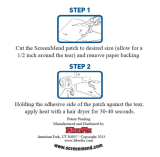
5
ENGLISH
Use: This suit should only be used in conditions appropriate for this type of CE
certication, within user qualications and in accordance with the regulations of the
local jurisdiction. The maximum operating depth limit is indicated by the CE standards
for certifying breathing apparatus (i.e. 50 meters).
Variation of Buoyancy: Improper use or misuse of this drysuit could result in the
loss of buoyancy control, including uncontrolled descents and uncontrolled rapid
ascents, which could result in decompression sickness, air embolism, drowning and
death. The presence of a volume gas inside the suit will be subject to the effects of
compression and expansion relative to the hydrostatic pressure. Inappropriate use of
the inator and the purge could cause squeeze during the descent as well as a too-fast
ascent, which could result in a decompression accident. An undergarment used in
combination with this drysuit shall allow free passage of air between the user’s body
and the deation device for proper exhausting and ination. Do not use the drysuit
as a lift bag. If you use the drysuit as a lift bag and lose the grip on the object, you
may become excessively buoyant. This may result in rapid ascent. Rapid ascent is
dangerous and may cause air embolism or decompression sickness, either of which
can result in serious injury or death.
Ination Gas: Introducing gas into the suit should serve only to control the internal
volume. Use of a drysuit will in no way replace the need for a buoyancy compensation
device (BCD). This suit is intended for use with compressed air. Do not use any other
gas or mixture for ination of the suit. Using oxygen enriched gas with a percentage of
oxygen exceeding 40% for ination presents a risk of re and explosion. When using
argon there is a risk of this gas getting into a full-face mask and the breathing system
through the hood. The effects of breathing argon are more narcotic than nitrogen when
under increased partial pressure.
Guidance & Warnings

















